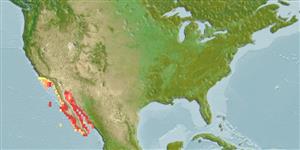Lớp phụ Cá sụn (cá mập và cá đuối) (sharks and rays) >
Rhinopristiformes (Shovelnose rays) >
Trygonorrhinidae (Banjo rays, Fiddler rays)
Etymology: Zapteryx: Greek, za = an augmentative particle + Greek, pteryx, wing, fin (Ref. 45335).
More on authors: Jordan & Gilbert.
Environment: milieu / climate zone / depth range / distribution range
Sinh thái học
Biển Cùng sống ở rạn san hô; Mức độ sâu 1 - 200 m (Ref. 37955), usually 1 - 22 m (Ref. 12951). Subtropical; 37°N - 20°N, 125°W - 108°W (Ref. 114953)
Eastern Pacific: California, USA to Mexico, records to Peru probably misidentifications.
Length at first maturity / Bộ gần gũi / Khối lượng (Trọng lượng) / Age
Maturity: Lm 68.0, range 57 - 77 cm
Max length : 83.0 cm con đực/không giới tính; (Ref. 48844); 97.0 cm (female)
Động vật có xương sống: 149 - 150. Spiral valve count: 8-10. Broad disc is about as wide as it is long; dorsal surface covered with numerous, small to large, scattered, stellate prickles; a single median row of enlarged thorns running along the mid-back; a broad, short snout; small, blunt, pebble like teeth; a dorsal fin that originates closer to the pelvic fin bases than to the caudal fin origin; a thick tail and a moderately large, rounded caudal fin without a distinct lower lobe. Tooth count: 60-75/60-75.
Coloration: The dorsal surface is sandy brown to dark gray, with several prominent black bars, and lighter below with dark spots on the posterior edge of the pectoral fins.
Generally in rocky areas mainly shallower than 10 m, moves offshore onto soft bottoms in autumn and winter; but may also be found on sandy bottoms (Ref. 37955, Ref. 114953). Reported from tide pools (Ref. 12951). Relatively docile, harmless rays that are easily approached by divers (Ref. 48844). Feeds mainly on mollusks and crustaceans (Ref. 37955). Ovoviviparous (Ref. 50449), with 4 to 11 pups in a litter (Ref. 51576). Maturity size of males at 64-70 cm TL, females at 57-77 cm TL; birth size at 15-18 cm TL (Ref. 114953). Seldom buries itself in sand. This species is a commercially important part of artisanal fisheries (Ref. 114953).
Etymology: The genus name comes from the Greek za, meaning intensive, and pteryx, meaning fin, in reference to the vertical fins being larger than those of skates. The species name comes from Latin, meaning made rough, in reference to the numerous stellate prickles on its back. (Ref. 48844).
Exhibit ovoviparity (aplacental viviparity), with embryos feeding initially on yolk, then receiving additional nourishment from the mother by indirect absorption of uterine fluid enriched with mucus, fat or protein through specialised structures (Ref. 50449).
During breeding season, male and female adult schools congregate in shallow areas of bays and lagoons (Ref. 51576). Parturition takes place three to four months after mating, with litters of 4 to 11 pups (Ref. 48844).
Compagno, L.J.V., 1999. Checklist of living elasmobranchs. p. 471-498. In W.C. Hamlett (ed.) Sharks, skates, and rays: the biology of elasmobranch fishes. Johns Hopkins University Press, Maryland. (Ref. 35766)
IUCN Red List Status (Ref. 130435)
Threat to humans
Harmless
Human uses
Các nghề cá: buôn bán nhỏ
Thêm thông tin
Các tài liệu tham khảoNuôi trồng thủy sảnTổng quan nuôi trồng thủy sảnCác giốngDi truyềnElectrophoresesDi sảnCác bệnhChế biếnNutrientsMass conversion
Các công cụ
Special reports
Download XML
Các nguồn internet
Estimates based on models
Preferred temperature (Ref.
123201): 18.1 - 28.5, mean 23.1 °C (based on 64 cells).
Phylogenetic diversity index (Ref.
82804): PD
50 = 0.6250 [Uniqueness, from 0.5 = low to 2.0 = high].
Bayesian length-weight: a=0.00724 (0.00267 - 0.01964), b=3.00 (2.76 - 3.24), in cm total length, based on LWR estimates for this (Sub)family-body shape (Ref.
93245).
Mức dinh dưỡng (Ref.
69278): 3.6 ±0.53 se; based on food items.
Generation time: 7.8 ( na - na) years. Estimated as median ln(3)/K based on 2
growth studies.
Thích nghi nhanh (Ref.
120179): Rất thấp, thời gian nhân đôi của chủng quần tối thiểu là hơn 14 năm (Fec = 4).
Fishing Vulnerability (Ref.
59153): High vulnerability (63 of 100).
Nutrients (Ref.
124155): Calcium = 9.41 [1.30, 36.16] mg/100g; Iron = 0.385 [0.093, 1.046] mg/100g; Protein = 19.9 [17.7, 21.9] %; Omega3 = 0.146 [0.062, 0.340] g/100g; Selenium = 16.5 [4.8, 49.0] μg/100g; VitaminA = 34.4 [11.2, 110.6] μg/100g; Zinc = 0.605 [0.292, 1.289] mg/100g (wet weight);
